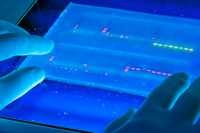








Pulsed field gel electrophoresis is a technique used for the separation of large deoxyribonucleic acid (DNA) molecules by applying to a gel matrix an electric field that periodically changes direction.
Standard gel electrophoresis techniques for separation of DNA molecules provided huge advantages for molecular biology research. However, it was unable to separate very large molecules of DNA effectively. DNA molecules larger than 15-20 kb migrating through a gel will essentially move together in a size-independent manner. At Columbia University in 1984, David C. Schwartz and Charles Cantor developed a variation on the standard protocol by introducing an alternating voltage gradient to improve the resolution of larger molecules.This technique became known as pulsed-field gel electrophoresis (PFGE). The development of PFGE expanded the range of resolution for DNA fragments by as much as two orders of magnitude.
The procedure for this technique is relatively similar to performing a standard gel electrophoresis except that instead of constantly running the voltage in one direction, the voltage is periodically switched among three directions; one that runs through the central axis of the gel and two that run at an angle of 60 degrees either side. The pulse times are equal for each direction resulting in a net forward migration of the DNA. For extremely large molecules (up to around 2 Mb), switching-interval ramps can be used that increases the pulse time for each direction over the course of a number of hours—take, for instance, increasing the pulse linearly from 10 seconds at 0 hours to 60 seconds at 18 hours.
This procedure takes longer than normal gel electrophoresis due to the size of the fragments being resolved and the fact that the DNA does not move in a straight line through the gel.